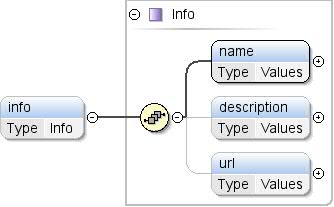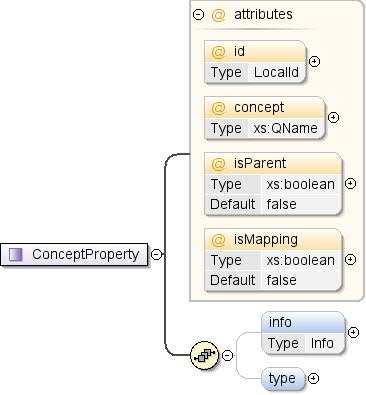Komponent: Concept Property
Zadbaj o dobrą organizację dzięki kolekcji
Zapisuj i kategoryzuj treści zgodnie ze swoimi preferencjami.
| Przestrzeń nazw |
http://schemas.google.com/dspl/2010 |
| Adnotacje |
Informacje tekstowe na temat właściwości koncepcji. |
| Diagram |
 |
| Typ |
Informacje |
| Właściwości |
|
| Model |
name , description{0,1} , url{0,1} |
| Dzieci |
description, name, url |
| Instancja |
<info>
<name>{1,1}</name>
<description>{0,1}</description>
<url>{0,1}</url>
</info>
|
| Źródło |
<xs:element name="info" type="Info" minOccurs="0">
<xs:annotation>
<xs:documentation>Textual information about the concept property.</xs:documentation>
</xs:annotation>
</xs:element>
|
| Przestrzeń nazw |
http://schemas.google.com/dspl/2010 |
| Adnotacje |
Typ danych właściwości koncepcji. |
| Diagram |
 |
| Właściwości |
|
| Atrybuty |
|
| Źródło |
<xs:element name="type" minOccurs="0">
<xs:annotation>
<xs:documentation>The data type of the concept property.</xs:documentation>
</xs:annotation>
<xs:complexType>
<xs:attribute name="ref" type="DataType" use="required"/>
</xs:complexType>
</xs:element>
|
Typ złożony: Concept Property
| Przestrzeń nazw |
http://schemas.google.com/dspl/2010 |
| Adnotacje |
Właściwość danego elementu (np. kraj
miasto). |
| Diagram |
 |
| Używane przez |
|
| Model |
info{0,1} , type{0,1} |
| Dzieci |
info, typ |
| Atrybuty |
| QName |
Typ |
Naprawiono |
Domyślny |
Użyj |
Adnotacja |
| koncepcja |
xs:QName |
|
|
opcjonalnie |
Odniesienie do pojęcia, który odpowiada wartościom.
usługi. Jeśli właściwość określa typ, zostanie użyty typ
musi pasować do typu wskazanej koncepcji. Odwołanie do
koncepcja zewnętrzna musi mieć postać
„prefix:other_koncepcja”, gdzie „prefiks” to
prefiks używany dla przestrzeni nazw zewnętrznego zbioru danych (patrz XML
przestrzeni nazw). |
| id |
LocalId |
|
|
opcjonalnie |
Identyfikator właściwości koncepcji. Ten identyfikator musi być:
które są unikalne (w odniesieniu do różnych atrybutów i właściwości).
Identyfikator może zostać pominięty, jeśli określono właściwość koncepcji. Pod tym kątem
, domyślnie tworzony jest identyfikator z wartością lokalną nazwę tagu
wymienionego pojęcia. Na przykład <property
concept="geo:country"/> jest odpowiednikiem elementu <property
id="country"
concept="geo:country"/> |
| isMapping |
xs:boolean |
|
fałsz |
opcjonalnie |
Jeśli ma wartość true (prawda), ta właściwość musi odnosić się do koncepcji,
ta właściwość wskazuje na mapowanie (1 do 1) między
i powiązanej koncepcji. Każde wystąpienie odwołania do
pojęcie jest wskazywane przez co najmniej 1 wystąpienie tego argumentu
koncepcję. |
| isParent |
xs:boolean |
|
fałsz |
opcjonalnie |
Jeśli ma wartość true (prawda), ta właściwość musi odnosić się do koncepcji,
ta właściwość określa hierarchiczną relację między
i pojęcie, do którego się odwołuje (np. kontynent
kraj). |
|
| Źródło |
<xs:complexType name="ConceptProperty">
<xs:annotation>
<xs:documentation>A property of a concept (e.g., the country of a city).</xs:documentation>
</xs:annotation>
<xs:sequence>
<xs:element name="info" type="Info" minOccurs="0">
<xs:annotation>
<xs:documentation>Textual information about the concept property.</xs:documentation>
</xs:annotation>
</xs:element>
<xs:element name="type" minOccurs="0">
<xs:annotation>
<xs:documentation>The data type of the concept property.</xs:documentation>
</xs:annotation>
<xs:complexType>
<xs:attribute name="ref" type="DataType" use="required"/>
</xs:complexType>
</xs:element>
</xs:sequence>
<xs:attribute name="id" type="LocalId" use="optional">
<xs:annotation>
<xs:documentation>The id of the concept property. This identifier must be unique within the concept
(across attributes and properties).
The id may be omitted if the concept property is specified. In that case, an id is
implicitly created with value the local name of the referenced concept. For instance
<property concept="geo:country"/>
is equivalent to
<property id="country" concept="geo:country"/></xs:documentation>
</xs:annotation>
</xs:attribute>
<xs:attribute name="concept" type="xs:QName" use="optional">
<xs:annotation>
<xs:documentation>A reference to a concept that corresponds to the values of the property.
If the property specifies a type, then the type must match the type of the
referenced concept.
A reference to an external concept must be of the form "prefix:other_concept_id",
where "prefix" is the prefix used for the namespace of the external dataset
(see XML namespaces).</xs:documentation>
</xs:annotation>
</xs:attribute>
<xs:attribute name="isParent" type="xs:boolean" use="optional" default="false">
<xs:annotation>
<xs:documentation>If true, then this property must reference a
concept, and this property denotes a hierarchical
relationship between this concept and the referenced
concept (e.g., the continent of a country).</xs:documentation>
</xs:annotation>
</xs:attribute>
<xs:attribute name="isMapping" type="xs:boolean" use="optional" default="false">
<xs:annotation>
<xs:documentation>If true, then this property must reference a
concept, and this property denotes a mapping
(1-to-1) relationship between this concept and the
referenced concept. Each instance of the referenced
concept is referenced by at most one instance of
this concept.</xs:documentation>
</xs:annotation>
</xs:attribute>
</xs:complexType>
|
| Przestrzeń nazw |
Brak przestrzeni nazw |
| Typ |
DataType |
| Właściwości |
|
| Aspekty |
| wyliczenie |
ciąg znaków |
|
| wyliczenie |
liczba zmiennoprzecinkowa |
|
| wyliczenie |
liczba całkowita |
|
| wyliczenie |
wartość logiczna |
|
| wyliczenie |
data |
|
| wyliczenie |
pomysł : koncepcja |
|
|
| Używane przez |
|
| Źródło |
<xs:attribute name="ref" type="DataType" use="required"/>
|
| Przestrzeń nazw |
Brak przestrzeni nazw |
| Adnotacje |
Identyfikator właściwości koncepcji. Ten identyfikator musi być unikalny
(w odniesieniu do różnych atrybutów i właściwości). Identyfikatorem może być
jest pomijany, jeśli określono właściwość koncepcji. W takim przypadku identyfikator to
niejawnie utworzona z wartością lokalną nazwę wskazanego pojęcia.
Na przykład <property Concept="geo:country"/> to
odpowiednik <property id="country"
concept="geo:country"/> |
| Typ |
LocalId |
| Właściwości |
|
| Aspekty |
|
| Używane przez |
|
| Źródło |
<xs:attribute name="id" type="LocalId" use="optional">
<xs:annotation>
<xs:documentation>The id of the concept property. This identifier must be unique within the concept
(across attributes and properties).
The id may be omitted if the concept property is specified. In that case, an id is
implicitly created with value the local name of the referenced concept. For instance
<property concept="geo:country"/>
is equivalent to
<property id="country" concept="geo:country"/></xs:documentation>
</xs:annotation>
</xs:attribute>
|
| Przestrzeń nazw |
Brak przestrzeni nazw |
| Adnotacje |
Odniesienie do pojęcia, który odpowiada wartościom atrybutu
usłudze. Jeśli właściwość określa typ, musi on pasować do parametru
lub typ wskazanej koncepcji. Odniesienie do zewnętrznej koncepcji musi
mieć postać „prefix:other_Concept_id”, gdzie
„prefiks” to prefiks używany dla przestrzeni nazw zewnętrznego
zbiór danych (patrz przestrzenie nazw XML). |
| Typ |
xs:QName |
| Właściwości |
|
| Używane przez |
|
| Źródło |
<xs:attribute name="concept" type="xs:QName" use="optional">
<xs:annotation>
<xs:documentation>A reference to a concept that corresponds to the values of the property.
If the property specifies a type, then the type must match the type of the
referenced concept.
A reference to an external concept must be of the form "prefix:other_concept_id",
where "prefix" is the prefix used for the namespace of the external dataset
(see XML namespaces).</xs:documentation>
</xs:annotation>
</xs:attribute>
|
| Przestrzeń nazw |
Brak przestrzeni nazw |
| Adnotacje |
Jeśli ma wartość true (prawda), ta właściwość musi odnosić się do koncepcji, a to
wskazuje hierarchiczną relację między tą koncepcją a
wskazane pojęcie (np. kontynent danego kraju). |
| Typ |
xs:boolean |
| Właściwości |
| użyj: |
opcjonalnie |
| domyślnie: |
fałsz |
|
| Używane przez |
|
| Źródło |
<xs:attribute name="isParent" type="xs:boolean" use="optional" default="false">
<xs:annotation>
<xs:documentation>If true, then this property must reference a
concept, and this property denotes a hierarchical
relationship between this concept and the referenced
concept (e.g., the continent of a country).</xs:documentation>
</xs:annotation>
</xs:attribute>
|
| Przestrzeń nazw |
Brak przestrzeni nazw |
| Adnotacje |
Jeśli ma wartość true (prawda), ta właściwość musi odnosić się do koncepcji, a to
wskazuje relację mapowania (1 do 1) między tą koncepcją a
wspomnianą koncepcję. Każde wystąpienie omawianej koncepcji jest
a do tego może odwołać się co najmniej 1 wystąpienie tej koncepcji. |
| Typ |
xs:boolean |
| Właściwości |
| użyj: |
opcjonalnie |
| domyślnie: |
fałsz |
|
| Używane przez |
|
| Źródło |
<xs:attribute name="isMapping" type="xs:boolean" use="optional" default="false">
<xs:annotation>
<xs:documentation>If true, then this property must reference a
concept, and this property denotes a mapping
(1-to-1) relationship between this concept and the
referenced concept. Each instance of the referenced
concept is referenced by at most one instance of
this concept.</xs:documentation>
</xs:annotation>
</xs:attribute>
|
Utworzono za pomocą
oXygen XML Editor.
O ile nie stwierdzono inaczej, treść tej strony jest objęta licencją Creative Commons – uznanie autorstwa 4.0, a fragmenty kodu są dostępne na licencji Apache 2.0. Szczegółowe informacje na ten temat zawierają zasady dotyczące witryny Google Developers. Java jest zastrzeżonym znakiem towarowym firmy Oracle i jej podmiotów stowarzyszonych.
Ostatnia aktualizacja: 2025-07-25 UTC.
[[["Łatwo zrozumieć","easyToUnderstand","thumb-up"],["Rozwiązało to mój problem","solvedMyProblem","thumb-up"],["Inne","otherUp","thumb-up"]],[["Brak potrzebnych mi informacji","missingTheInformationINeed","thumb-down"],["Zbyt skomplikowane / zbyt wiele czynności do wykonania","tooComplicatedTooManySteps","thumb-down"],["Nieaktualne treści","outOfDate","thumb-down"],["Problem z tłumaczeniem","translationIssue","thumb-down"],["Problem z przykładami/kodem","samplesCodeIssue","thumb-down"],["Inne","otherDown","thumb-down"]],["Ostatnia aktualizacja: 2025-07-25 UTC."],[],["ConceptProperty defines a characteristic of a concept, with optional `info` and `type`. The `info` contains text about the property, including `name`, `description`, and `url`. `type` specifies the data type. Attributes include an optional `id` for unique identification, an optional `concept` to reference related concepts, `isParent` (hierarchical relationship), and `isMapping` (1-to-1 relationship), both booleans, defaulting to `false`. The `@ref` attribute is required for type and defines the data type of the referenced concept.\n"]]



